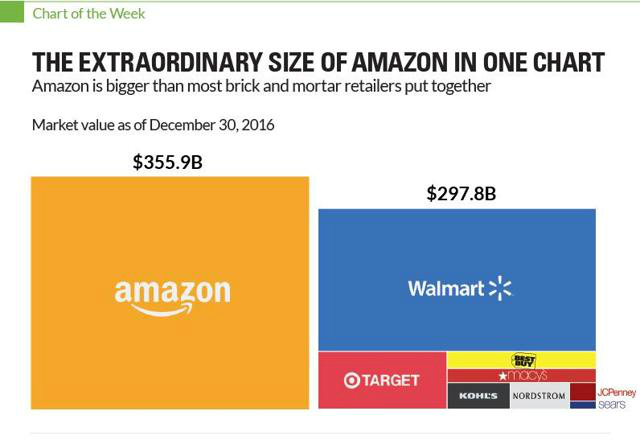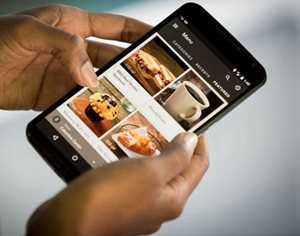Looking at the Target/Google Partnership from Different Angles
 Target and Google announced that they are expanding their delivery partnership to the entire continental U.S, which will allow consumers to shop Target across the U.S. via Google Express, including by voice.
Target and Google announced that they are expanding their delivery partnership to the entire continental U.S, which will allow consumers to shop Target across the U.S. via Google Express, including by voice.
Have you ever heard of a matryoshka doll? You know - the one that is a set of wooden dolls which separates, top from bottom, to reveal a smaller figure of the same sort inside, which has, in turn, another figure inside of it, and so on. This piece of news stated in my opening paragraph reminded me of a matryoshka doll as it consists of a few other news inside, and throughout this article, I will be repeating the same statement, except, every single time when I do that, we will be looking at it from a different angle. Here we go:
Ganging Up on Amazon?
“Target and Google announced that they are expanding their delivery partnership to the entire continental U.S, which will allow consumers to shop Target across the U.S. via Google Express, including by voice.”
Under the newly expanded partnership, Target shoppers will be able to shop on any device (including Android TV) where the Google Assistant is available. Until now, the voice platform has been available on the Google Home and on Android TVs. Soon, it will launch on iPhones and Android phones, so customers can order items, using voice, while mobile.
By adding Target to its arsenal of retailers on the Google Express platform including Wal-Mart, Costco, Kohl’s and Ulta, Google has strengthened its hand to compete against Amazon’s dominance with its Echo devices. There is still a long way to go for Google but considering Amazon launched Echo voice assistants in late 2014, whereas Google made its debut with Google Home earlier this year, Google definitely seems to have become a formidable challenger in that market as it continues to go up against Amazon. If you ask if Google could beat Amazon and become a leader instead of a challenger, well, it seems to be extremely hard merely relying on technology but as Google is also aware of this fact, the company is trying to win this in a strategic way by teaming up with well-known brick-and-mortar stores.
Teaming up with Google also serves those well-known brick-and-mortar stores as recent research from One Click Retail (OCR) claimed that Amazon is enjoying an average year-over-year growth (YoY) rate of 38% compared to the total retail market’s combined growth average of 6% for U.S. housewares, health & personal care and beauty industries. "What we're currently witnessing is eCommerce finally beginning to disrupt everyday household products, with Amazon leading the pack," said Spencer Millerberg, OCR's CEO. "Consumers benefit from buying these items in bulk and having them delivered right to their doorsteps. Our numbers continue to demonstrate just how significant these everyday items are in helping to drive Amazon's exponential YoY growth."

Additionally, according to Slice Intelligence, Amazon accounted for 53% of all retail e-commerce sales growth in 2016. As CNN reported, half of all U.S. households are now Amazon Prime subscribers. With Google not having warehouses full of products and well-known brick-and-mortar stores like Walmart and Target not having smart speaker hardware, it creates a perfect win-win situation for them to bring those powerhouse teams together ganging up on Amazon.
Will Omnichannel Experiences Save Brick-And-Mortar Retailers?
“Target and Google announced that they are expanding their delivery partnership to the entire continental U.S, which will allow consumers to shop Target across the U.S. via Google Express, including by voice.”
Another benefit of this agreement is that starting next year, Target shoppers will have the option to pick up their Google Express orders at a Target store, with the items ready in two hours. The buy-online/pick-up-in-store option has been a powerful tactic for brick-and-mortar stores to compete with Amazon and to drive foot traffic, even though this competitive edge was at stake with Amazon’s acquisition of Whole Foods.
As e-commerce has substantially evolved, Amazon came on stronger than ever with its value  proposition including fast free shipping, free returns, an endless aisle of products, and low prices. As a result, many online retailers feel that they would be defeated if they do not sell through Amazon despite the major downsides to relying too heavily on the e-commerce giant. However, as I previously stated in my article that discusses the reasons behind U.S retail store closures and bankruptcies, as digital transformation continues to engulf everything in its path, opportunities and challenges will equally get off the ground. Therefore, in that piece, I suggested retailers to not only adopt a mobile-first approach but also innovate new ways of delivering exceptional shopping experiences, instead of pointing the finger at Amazon, as I believe that the secret sauce comes in the form of offline and online merging like Amazon has been doing to thrive.
proposition including fast free shipping, free returns, an endless aisle of products, and low prices. As a result, many online retailers feel that they would be defeated if they do not sell through Amazon despite the major downsides to relying too heavily on the e-commerce giant. However, as I previously stated in my article that discusses the reasons behind U.S retail store closures and bankruptcies, as digital transformation continues to engulf everything in its path, opportunities and challenges will equally get off the ground. Therefore, in that piece, I suggested retailers to not only adopt a mobile-first approach but also innovate new ways of delivering exceptional shopping experiences, instead of pointing the finger at Amazon, as I believe that the secret sauce comes in the form of offline and online merging like Amazon has been doing to thrive.
"So it is exciting to see, that innovative approach is prevailing in the market. ,” Marc Lore, head of Wal-Mart’s U.S. e-commerce business, for instance stated: “Next year, we will also leverage our 4,700 U.S. stores and our fulfillment network to create customer experiences that don’t currently exist within voice shopping anywhere else,” This will include using voice command to pick up orders in-store and using voice shopping to purchase fresh groceries, he said.
Another innovative aspect of Target’s expanded partnership is offering a quick re-order experience by linking an existing Target account to Google Express, meaning customers will be able to more conveniently reorder products, because the service will know what exactly each person prefers to buy and in what quantities. To put this into perspective, if you are running out of feta cheese or diapers, your Google Assistant will already know which size and variety you bought from Target based on past purchases. If you are concerned that soon enough you will not be able to stroll the aisles and end up buying your 35th tablecloth, another Halloween ornament, and a lipstick with slightly different shade than your other five lipsticks when all you came in for was a dozen of eggs, Target puts your doubts to rest as you will also be able to opt-in to receive personalized recommendations. Additionally, the retailer also indicated that they are teaming up with Google to create innovative digital experiences using voice and other cutting-edge technologies to elevate Target’s strength in style areas such as home, apparel, and beauty. All of these won’t be available until next year, though.
“At Google, we are focused on continued innovation and making Google Express a platform to help retailers like Target offer consumers a high quality seamless, end-to-end shopping experience,” said Daniel Alegre, Google’s president of retail and shopping.
This additional feature reminded me of our interview with Loren Jarrett, Chief Marketing Officer at Progress as when it comes to other channels and devices such as conversational systems and connected devices, she believes that we will see a revolutionary change in how people interact with computers, therefore she thinks that we should embed those new emerging channels into the process of how we are doing everything. At a very simplistic level, she gave the process of grocery shopping as an example: “The sensor in my fridge will know what food I am running low on so based on all the big data out there about me, my health needs, and my food preferences, the right food will be automatically delivered to my door, at a time convenient for me” she said and even claimed that we will conduct a meaningful conversation with our fridge through voice-activated interface. She also gave an example of a potential conversation: “Hey Loren, you wanted 1% milk last time, but I know that usually, you like whole, so what do you want to do today?” All these conversations lead me to our third angle:
at Progress as when it comes to other channels and devices such as conversational systems and connected devices, she believes that we will see a revolutionary change in how people interact with computers, therefore she thinks that we should embed those new emerging channels into the process of how we are doing everything. At a very simplistic level, she gave the process of grocery shopping as an example: “The sensor in my fridge will know what food I am running low on so based on all the big data out there about me, my health needs, and my food preferences, the right food will be automatically delivered to my door, at a time convenient for me” she said and even claimed that we will conduct a meaningful conversation with our fridge through voice-activated interface. She also gave an example of a potential conversation: “Hey Loren, you wanted 1% milk last time, but I know that usually, you like whole, so what do you want to do today?” All these conversations lead me to our third angle:
Conversational Systems are the Future
“Target and Google announced that they are expanding their delivery partnership to the entire continental U.S, which will allow consumers to shop Target across the U.S. via Google Express, including by voice.”
In the previous segment where I discuss how the partnership will provide consumers with more omnichannel experiences, the “including by voice” part of the statement above has already been explained. Voice-based shopping still has a long way to go as far as user adoption goes. I mean, I have no tech-savvy people around me just yet who are ordering their toothpaste through a smart speaker like Google Home or Amazon Echo but I think, that’s exactly the point behind Google’s efforts to rapidly gang up on Amazon with the retail giants such as Walmart and Target so they could stop the e-commerce behemoth getting the lion's share of that new market which is emerging so rapidly. In fact, Gartner predicts that 75% of US households will have smart speakers like Amazon Echo or Google Home by 2020. Therefore, we will discuss this new market from the retailer standpoint in this segment.
omnichannel experiences, the “including by voice” part of the statement above has already been explained. Voice-based shopping still has a long way to go as far as user adoption goes. I mean, I have no tech-savvy people around me just yet who are ordering their toothpaste through a smart speaker like Google Home or Amazon Echo but I think, that’s exactly the point behind Google’s efforts to rapidly gang up on Amazon with the retail giants such as Walmart and Target so they could stop the e-commerce behemoth getting the lion's share of that new market which is emerging so rapidly. In fact, Gartner predicts that 75% of US households will have smart speakers like Amazon Echo or Google Home by 2020. Therefore, we will discuss this new market from the retailer standpoint in this segment.
The new wave of AI-assisted services like Apple Siri, Microsoft Cortana, Facebook’s M, Alexa-powered Amazon Echo, and Google Home have already started changing how we browse the web. This is a revolutionary change in how people interact with computers. Microsoft's CEO Satya Nadella has once famously said: "It's technology that's inevitable," and referred to the development of chatbots as a way to create “conversation as a platform.”
On the retail side of things, more brands have started harnessing the technology to deliver content, increase engagement, and strengthen brand affinity. Tommy Hilfiger, for example, launched a chatbot on Facebook Messenger where the brand enables personalized, scalable conversations with consumers. It essentially learns to understand consumer habits, context, and intent to better predict and provide the content, information or engagement users are seeking. Sephora, a beauty retailer, on the other hand, launched a Kik chatbot that offers a quiz to any users to message it. The bot uses the quiz results to serve up personalized product recommendations and beauty tips.
At Starbucks, for instance, mobile payments currently account for more than 25% of  transactions at its U.S. operated stores. Starbucks Mobile Order & Pay makes up more than 7% of total U.S. transactions. As the leading coffee brand believes in the importance of redeveloping its tools along the lines of the new consumer reality, Starbucks keeps innovating new ways of engaging with customers through fun and personalized experiences. The company has recently introduced a conversational ordering system called "My Starbucks Barista" which is a digital assistant powered by Apple's Siri. It will allow customers to place orders via voice command or messaging. On top of that, the platform will deliver real-time personalization and product suggestions. To do so, Starbucks will track your buying habits and use that information to recommend your favorite food and drinks so you will be served based on your tastes and preferences.
transactions at its U.S. operated stores. Starbucks Mobile Order & Pay makes up more than 7% of total U.S. transactions. As the leading coffee brand believes in the importance of redeveloping its tools along the lines of the new consumer reality, Starbucks keeps innovating new ways of engaging with customers through fun and personalized experiences. The company has recently introduced a conversational ordering system called "My Starbucks Barista" which is a digital assistant powered by Apple's Siri. It will allow customers to place orders via voice command or messaging. On top of that, the platform will deliver real-time personalization and product suggestions. To do so, Starbucks will track your buying habits and use that information to recommend your favorite food and drinks so you will be served based on your tastes and preferences.
Whether it is a chatbot, a virtual assistant, or a voice-activated assistant, the level of personalization that these technologies can deliver is not limited to only customers. Another important aspect of the business is brand identity, and cutting out human interaction can easily spoil it. However, the vendors are enhancing their platforms to deliver human-like responses, so brands can train their chatbots to have the same voice and tone, just like train their customer-facing employees, for instance, launched an external API for developers, which Taco Bell has already publicized with its in-the-works ‘Tacobot‘, apparently capable of taking your order and doing so with ‘personality’. This is one of the areas of conversational systems for exploration by businesses.
As a marketer, you may think that it is too early to adopt this new content delivery channel, then let me respond to that with a statement by Kipp Bodnar, Chief Marketing Officer, Hubspot: “Marketers’ best leverage exists when there’s a new audience that’s growing but not a lot of competition trying to reach that audience. When you invest in an emerging technology, you can be in front of a growing audience in a far less competitive landscape.”

Venus Tamturk
Venus is the Media Reporter for CMS-Connected, with one of her tasks to write thorough articles by creating the most up-to-date and engaging content using B2B digital marketing. She enjoys increasing brand equity and conversion through the strategic use of social media channels and integrated media marketing plans.